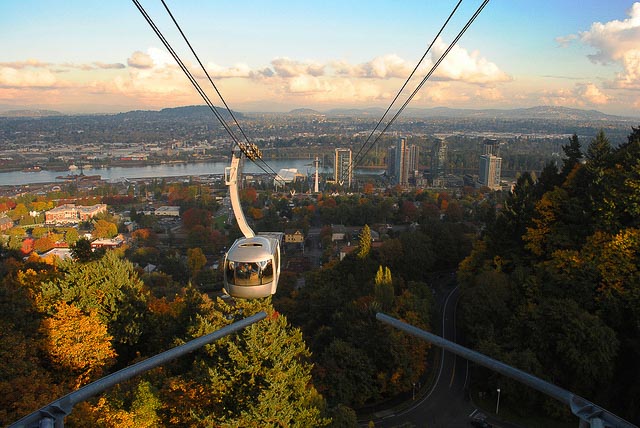The systems may seem far out, but cities shouldn't dismiss cable-propelled transit, or CPT, a pair of researchers from the Kinder Institute for Urban Research argue.
In a new Los Angeles Times op-ed, Kinder Institute Director Bill Fulton and Kyle Shelton, a postdoctoral fellow, argue that the systems play a critical role in cities where steep inclines and other geographic barriers impede access to transit.
The two experts highlight the case of the Angels Flight funicular in Los Angeles, which has a century-long history but has sat unused since 2013.
The two write in their op-ed:
"Setting aside safety concerns, many Americans dismiss CPTs as novelties or tourist traps. This view, however, ignores how very useful they are in topographically challenged cities such as Los Angeles. CPTs can provide transit connections to hard-to-reach places without requiring large-scale, disruptive construction — no small advantage."
You can read the full op-ed here. In the meantime, check out these images of some of the most breathtaking cable-propelled transit systems in the U.S. and around the world.
Portland Aerial Tram -- Portland, Oregon
 The Portland Aerial Tram, which opened in 2006, connects commuters to the Oregon Health & Science University campus. Image via flickr/C.M. Keiner.
The Portland Aerial Tram, which opened in 2006, connects commuters to the Oregon Health & Science University campus. Image via flickr/C.M. Keiner.The system provides a critical link between transit stops at Portland's Waterfront district and jobs at the Oregon Health & Science University campus, which is set high on a hill. The system opened in 2006. Last year, it carried its 10 millionth passenger.
Angels Flight -- Los Angeles
Located in the Bunker Hill area of downtown L.A., the original Angels Flight dates to 1901 (the newer version opened in 1996). But accidents -- including one that proved fatal in 2001 -- have plagued the funicular's operations, which have been suspended since 2013.
Roosevelt Island Tramway -- New York City
At one point, it was the only commuter aerial tramway in all of North America. Opened in 1976, the system rises high above the East River. In 2006, passengers got stranded for 7 hours. Concerns about safety were addressed in 2010, when the system underwent a multi-million dollar renovation.
Peak Tramway -- Hong Kong
The system, which carries passengers to the most elevated parts of Hong Kong Island, is operated by a hotel chain and serves an estimated 4 million people annually. The earliest version of the funicular dates to the 1880s, but the current iteration was built in 1989.
Bondinho do Pão de Açúcar -- Rio de Janeiro
The Sugarloaf Cable Car is famous for its stunning views that culminate in a stop at a 1,300-foot mountain. In 1979, James Bond fought the villain Jaws on a cable car in the movie Moonraker. Multiple stuntmen have also walked along its cables.
Elevador da Glória -- Lisbon
The funicular links Lisbon's Baixa neighborhood to the Barrio Alta. In a city that is very steep, the funiculars are iconic and play an important role. The initial Elevador da Glória opened in 1885. The nearby Elevador da Bica funicular opened in 1892.
Duquesne Incline -- Pittsburgh
The funicular, which climbs Mount Washington, was completed in 1877 as a way to help move cargo and later passengers to Pittsburgh's South Side. It was closed in 1962, but local residents raised funds to re-open the incline in 1963.
Metrocable -- Medellín
The gondola, which opened in 2004, is credited with contributing to the revitalization of Medellín by providing much-needed transit access to underdeveloped parts of the city. Unlike aerial gondolas in many other parts of the world, Metrocable is fully integrated into the city's transit system.
Teleférico de Gaia -- Porto, Portugal
The gondola spans the Duoro River, providing a connection between the city's historic center north of the river and its famous wine lodges to the south. The system opened in 2011 and provides stunning views of Porto's famous Dom Luís I Bridge.









